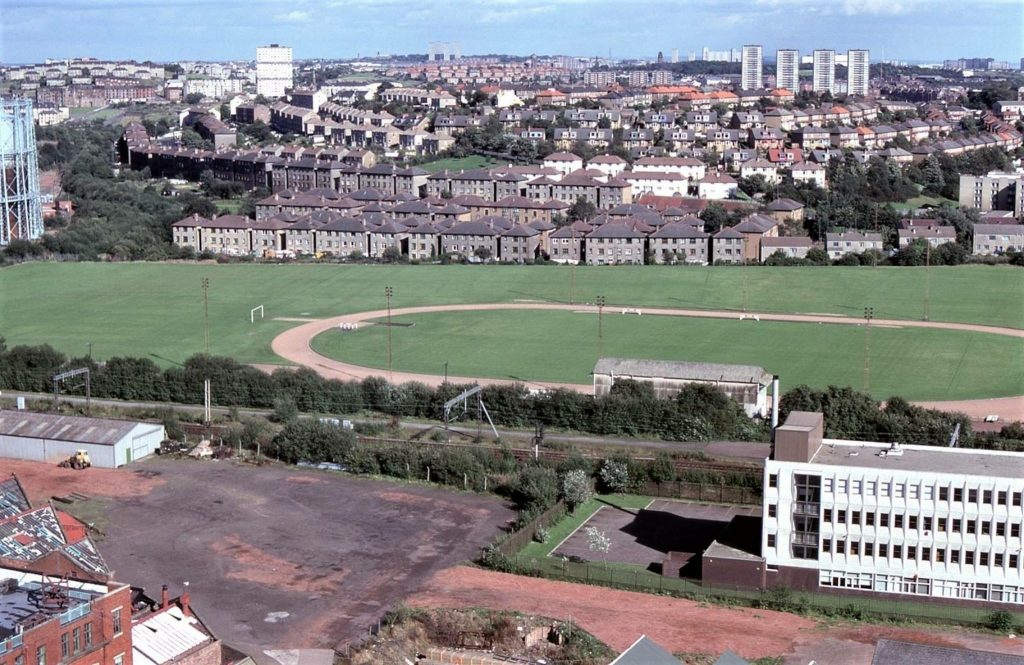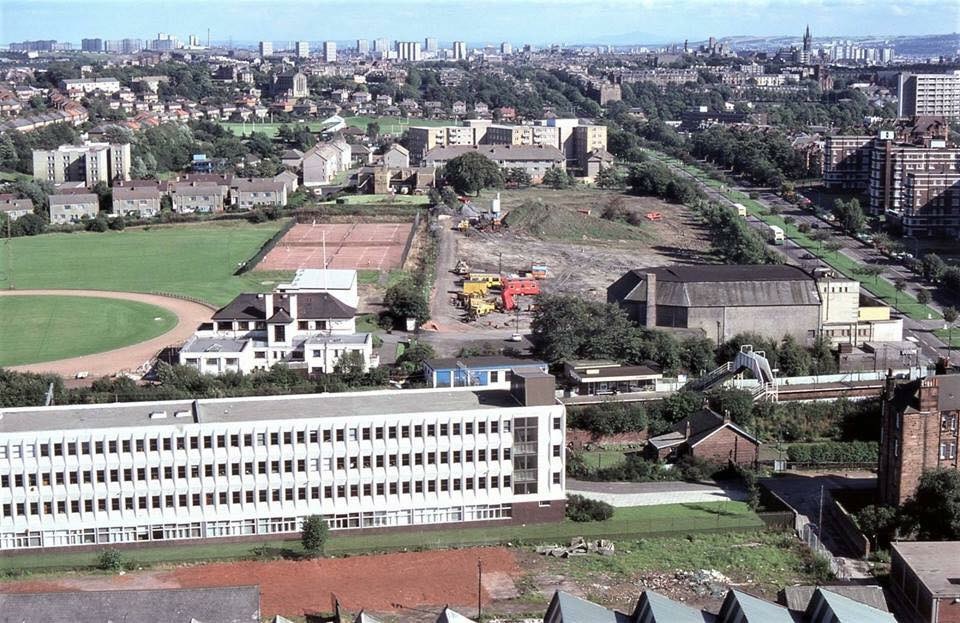The Pavilion at Westerlands.
The original pavilion at Old Anniesland: ladies accommodation on the left
Glasgow University in my time always provided well for athletics. There was the huge grass area at Garscadden which was used for all sorts of sports and for a number of years was the start of a cross-country route that went up along the Forth & Clyde Canal bank to the Great Western Road Boulevard using the grass island in the middle until, halfway between Drumry Road and Kilbowie Road in Clydebank it crossed on to the hilly land around Braidfield Farm and Drumchapel before heading back to Garscadden the way it had come. There was also Westerlands in Ascot Drive at Anniesland Cross. Of the two, Westerlands was by far the better known. It was a wonderful facility which as well as hosting University championships at all levels, held county, District and National Championships as well as many invitational events.
The original GUAC training ground had been at the University Recreation Ground on the ground that now houses the Zoology and Chemistry buildings: on the west was the Western Infirmary, on the east was a path from the South Front roadway. It was clearly not big enough to support a club with had rugby teams, tennis, cycling, cricket and athletics competing for the available space. Various venues were investigated before Anniesland was settled upon. The “University Grounds, Anniesland” were opened for use in October 1913. As indicated by the photograph above, the University has been using grounds away from the Recreation Grounds for some time and Old Anniesland had been leased before the purchase of their own ground.
The new Pavilion, the one we all knew which is pictured at the top of the page, was officially opened on 16th May 1926 by the University Rector, Lord Birkenhead. The Principal, Sir Donald McAlister donated a flag (unfurled by Lady McAlister) and the flagstaff on which it was erected was one of the masts of the old Clyde passenger ship PS Benmore gifted by Mr Samuel Galbraith. The ‘Glasgow Herald’ reported the occasion –
“The annual sports meeting of the Glasgow University athletic club, held at Westerlands on Saturday, was note worthy in two respects. It was the first occasion in which the Lord Rector had joined the students on the athletic field, and the opening of the new pavilion marked the successful close of a movement begun 15 years ago to place Gilmorehill on a footing worthy of the other traditions of the University. In his undergraduate days at Oxford the Earl of Birkenhead was a keen athlete, and no doubt his acceptance of the invitation to be present on Saturday was influenced by this fact, but his participation should have its effect in stimulating the activities of the students while also imparting a human touch to his office which might be emulated by his successors. His presence was reflected in the attendance which was gratifyingly large, and the club exchequer should benefit accordingly.”
The next big improvement was the cinder track, an issue first brought forward officially in 1955. After gaining the necessary approval, there was a delay of three years while drainage improvements were carried out and in 1960 a 440 yards track was marked out on the grass at the University ground at Garscadden while the work was carried out. Red ash was chosen over black ash, which was used on most cinder tracks around the country including Meadowbank and Ibrox, because it offered a faster surface than the black, better recovery and easier maintenance. The track was officially opened on 15th April 1961 in a match between the Achilles and Atalanta clubs, the meeting sponsored by the ‘Glasgow Herald’ which reported as follows:
“GROUND RECORDS AT WESTERLANDS: Achilles defeat Atalanta. Seven track and field ground records were broken at Westerlands on Saturday in a meeting sponsored by The Glasgow Herald, which followed the official opening of Glasgow University’s new blaes running track by the principal, Sir Hector Hetherington. The meeting consisted of a 16 event match between Atalanta and Achilles, which the latter won by 55 points to 47, a five event women’s contest which the Scottish Women’s Athletic Association beat a Scottish Universities team by 29 – 6, and two invitation events.”
The invitation events were a 100 yards race in which MG Hildrey won in 10.2 seconds from G Cmela (London AC) and A Meakin (Thames Valley), and a mile which Graham Everett won from T Ceiger (Achilles) and S Taylor (Manchester AC) in 4:12.8. The records were set in the shot by D Harrison (Achilles) with 52’9″, JM Parker (Achilles) in the 120 yards hurdles with 14.9 seconds, MC Robinson (Achilles) in the 440 yards hurdles with 55.4 seconds, D Stevenson (Achilles) and JR McManus (Atalanta) both cleared 12′ 5.75″ in the pole vault, CJ Bacon of Achilles threw the javelin 203′ 11″, Graham Everett in the Invitation Mile and the SWAAA Women’s 4 x 110 yards relay team. The best race of the afternoon was however one not yet mentioned – the Three Miles match race between Alastair Wood and DM Turner in which they ran together until the back straight of the last lap when Wood moved clear to win by 50 yards in 14 min 16.6 sec. Another familiar name on the programme was Adrian Metcalfe (Achilles) who won the 100 yards in 10.6 seconds from A Millar of Atalanta.
The track was an instant hit with athletes and officials alike – a good track, an excellent ‘perimeter’ for warming up purposes, right next to a good train station and on many bus routes as well as being well away from the crowds in the city centre. Athletes from a variety of cubs had always trained there with permission from the University but now it became THE midweek training venue, particularly at lunchtimes when many of the country’s best athletes gathered for joint sessions. The real accolade came with the SAAA Championships in 1963 – a warm windless afternoon which did nothing to assist the marathon runners at all. It made for a good day out for the spectators, for a change the sprinters had the sun on their backs, and the field eventers could have had no complaints. It was Jim Alder’s first marathon and he started a bit too fast for the conditions but for all that was three minutes up on Ian Harris at 20 miles – but finished 7 minutes down in second place. Inside the arena on the track Ming Campbell won the 100, 220 and 440 while a previous winner, WH Welsh, looked on; Graham Everett won the Mile, Fergus Murray beat Andy Brown and Bert McKay in the Three Miles, John Linaker beat Tom O’Reilly in the steeplechase, Crawford Fairbrother won the high jump from Davie Cairns, David Stevenson won the pole vault – in short all the big names of Scottish athletics were there.
The next step for any forward thinking athletic club was the installation of floodlights. The rugby section was the first to push for these and they had their lights for training by June 1949. However it took some hard thinking before the lights were finally installed on the main rugby pitch and the running track in 1966. The official opening was on Tuesday 18th October of that year with a challenge rugby match and an invitation mile race. The rugby featured many real big stars of the game – it was a University Select v Hawick match after all – and among those on the field were Sandy Carmichael, Colin Telfer, B Lockhart, CS Calder and D Deans. There was also a good invitation mile at half-time which was won by Hugh Barrow of Victoria Park in 4:14, almost three seconds in front of Graeme Grant of Dumbarton AAC and Duncan Middleton of Springburn Harriers – both GB internationalists over 800m – with Dick Hodelet, Jim Brennan and Mike McLean in the supporting cast.
It was in September 1963 that the first Glasgow University Open Road Race was run over a testing course which started and finished at Westerlands. Good links, close to Glasgow, hard course, excellent changing facilities, good catering, staring at 3:00 pm almost every runner was home clean and washed in time for tea – it was all that a runner could want. It was an instant hit. The venue was still used during the week for training by GU athletes, it was available for training purposes at lunch times by other athletes provided they had a users pass. The groundsman usually checked the pass if you were a new athlete in attendance – and sometimes when you had been coming for ages. The track was of a quality to be used for SAAA Championships and in addition to domestic functions, there were international fixtures and such events as Atalanta v Cornell University v a Scottish Select. Atalanta was a team of combined Scottish University athletes which met from time to time for bigger fixtures such as against the combined Oxbridge team, Achilles. The Pavilion? Well there were changing rooms on the ground floor as you went in as well as the Bar and then down below there was more changing and showers – lots more changing. On Race Day, entries were taken and numbers issued just inside the front door. It was at a time when athletes arrived fully dressed, changed at the ground and after the race could and would shower before going into the Bar for whatever was on offer while they waited for the results. None of this rushing in already stripped, running the race and then racing to your car to head off home. Much more civilised and much more fun.
Rugby teams on the night of the first floodlit meeting
There was often a hockey match or two going on while the runners ran around the perimeter (the far side was just over 300 yards long) warming up before jogging round the corner for the start in Crow Road. The race finished on the track – see Alastair Douglas’s story about Ian Hamer defeating Nat Muir – before the athletes went for a cool-down jog and then showered. It was ideal for the post-race fun and frolic with many a quiet and dark nook for private conversation and the track was just there for the Chunder Mile
It was spacious, warm and welcoming. It had all you would want in a race headquarters and more besides. When the University had to sell it and Garscadden for housing developments, a lot was lost. Nevertheless they kept investing in athletics with a large share in the funding for the Kelvin Hall indoor arena and the big, well-equipped Garscube Sports complex.
Westerlands was however known for other events – many indoors. If you were an athlete and a party animal, Westerlands was your spiritual home. The Discos were famous and the various ‘track events’ after dark on the evening of the Uni Road Race would have been unthinkable at any other athletic venue in the country. The famous beer fuelled mile races have been mentioned a lot and the impression has maybe been given that they were male only. Not true. As evidence, I quote from an article by Doug Gillon which took up almost a full page of the ‘Herald’ one Monday morning in the mid-90’s. Only the name has been omitted to save some blushes!
“The university-educated among the spectators – and that represented the majority at Westerlands on Saturday night – soon deduced from the two tables parked in front of the track and laden with beer that this was no ordinary athletics event. Though the annual 4.8 mile Glasgow University Road Race, held earlier in the day, was ostensibly the main attraction, and had been climaxed by record-breaking runs from Glen Stewart and Phil Mowbray, there were substantially more spectators for the quaintly-named Chunder Mile.
Neither Stewart nor Mowbray lined up for the second race – perhaps they simply knew they were on a hiding to nothing. By the light of day [Miss X] is an outstanding runner. The British cross-country internationalist proved it by winning the women’s event in the afternoon, albeit more than five minutes down on Stewart, but in the dark of the night she can intimidate even the best men. It is part of student tradition that race protagonists return at night, but the males among the 20 who lined up again on Saturday were clearly unprepared. Each competitor then drank one pint of beer before each of the four laps (Female dispensation: 4 x half pint). The combination of ale, interspersed with flat-out running, is apt to disturb the stomach’s equilibrium – hence Chunder Mile. Phil Ross from Alness set a world record of 5 min 27 sec in 1989 on the same Glasgow track and never spilled a drop. It was as well that Nature cast a cloak of clinging mist over proceedings, though the druggies and non drinkers now evening habitués of the dilapidated Westerlands grandstand, were bemused by the surreal scene: males running naked, one in drag, but the women, to the continuing disappointment of male on-lookers, tending to be rather more demurely dressed.
[Miss X], a third year medical student on a seven year medicine and sports science course, quaffed her quota of four half pints with relish, finishing in 6:01 more than half a lap ahead of her closest male rival. Jeers of derision from her monstrous regiment of supporters, at male weakness, mercifully drowned the noise of their wretched discomfort, and prompted suggestions that the lithe [Miss X] should be handicapped, ie pints not halves. This is not however an area in which the Scottish Athletics Federation has locus to adjudicate.”
The article goes on to report on the race but the extract above gives the atmosphere of the thing! On at least one other occasion, one woman was reported to have run in black lacy undies and boots. Inside the Pavilion? Well, Mr Allman proving that he was well named, the chap in the kilt spending a large part of the evening showing everyone what Scotsman wore under the kilt, the can-can (performed by men and women in separate groups, the women appropriately clad).
It was all typical student high-jinks but the focus was Westerlands! And to think that the political clubs in the Union thought ‘building the only living human pyramid in history’ was a bit of a jolly jape!
The Westerlands Cake: at the farewell party in December 1997 after 72 years
Helen Champion, President of the University Sports Association, and Des Gilmore
Scottish athletics suffered a real blow when the club moved from Anniesland to Maryhill – there was a perimeter, there were excellent dressing rooms and meeting rooms, and all sorts of things but where there was an atmosphere of a single unit, a ‘wholeness’ about Westerlands, there was none remotely similar at the new venue. In addition all the various idiosyncratic stairs and linked dressing rooms in the basement, the bar right inside the front door – all gone. We should be grateful that a new facility was built and so much money lavished on it but there was intense regret at the passing. The athletic club had a farewell party though, and a special cake was baked for the occasion – see above!
The potted history at the start was mainly from “GUAC: The Story of the First Hundred Years.” published by the Glasgow University Athletic Club and written by RO McKenna in 1981. It’s a very good and very detailed read. If you can get hold of a copy, do so. You won’t regret it. The builders moved – the end of an auld sang –
![Pavilion[1]](http://www.scottishdistancerunninghistory.scot/wp-content/uploads/2015/10/Pavilion1.jpg)
![Westerlands_accommodation[1]](http://www.scottishdistancerunninghistory.scot/wp-content/uploads/2015/10/Westerlands_accommodation1.jpg)
![Westerlands%20CC%20EUAC%201904[1]](http://www.scottishdistancerunninghistory.scot/wp-content/uploads/2015/10/Westerlands-CC-EUAC-19041.jpg)
![Westerlands_turfing[1]](http://www.scottishdistancerunninghistory.scot/wp-content/uploads/2015/10/Westerlands_turfing1.jpg)
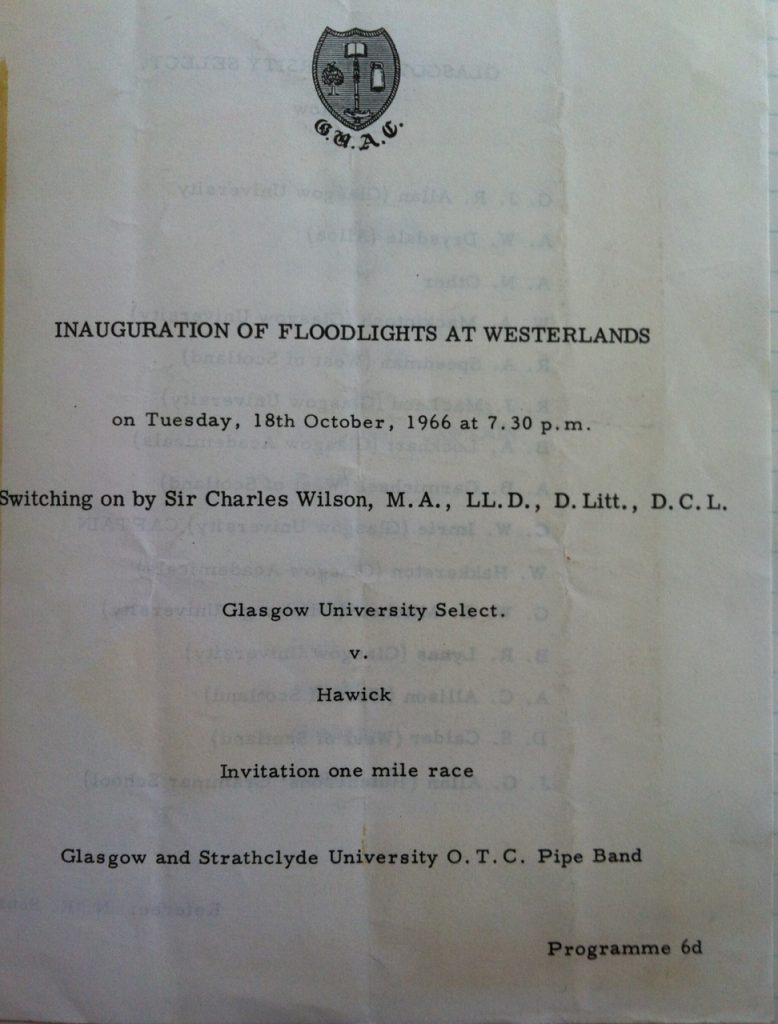
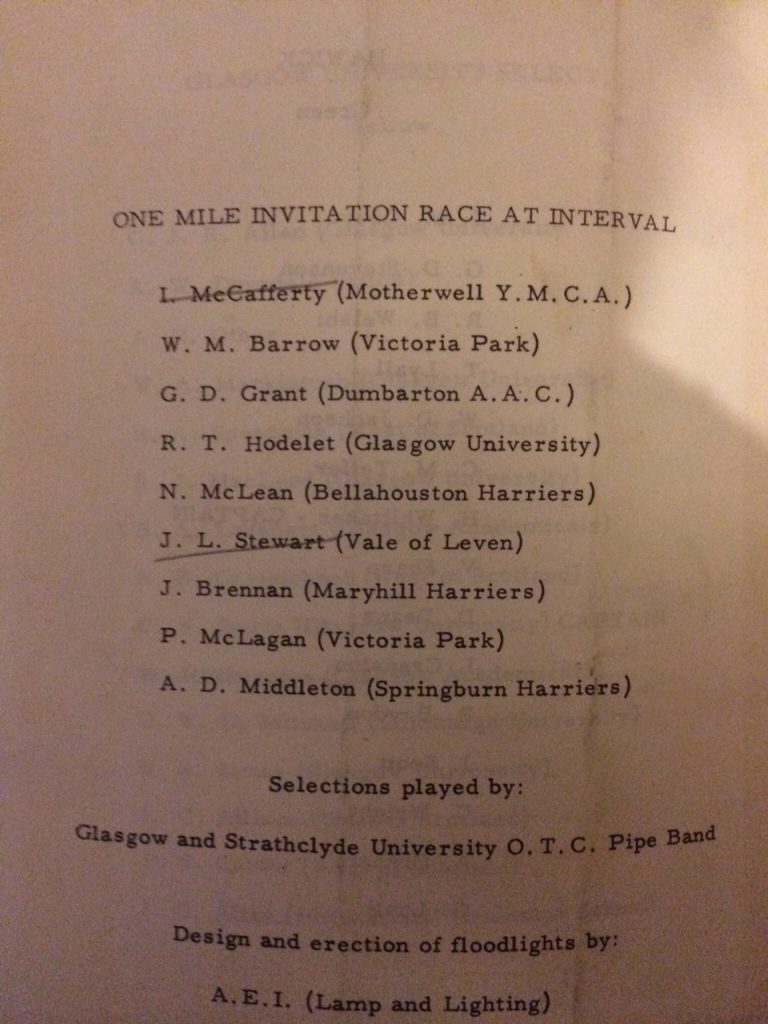
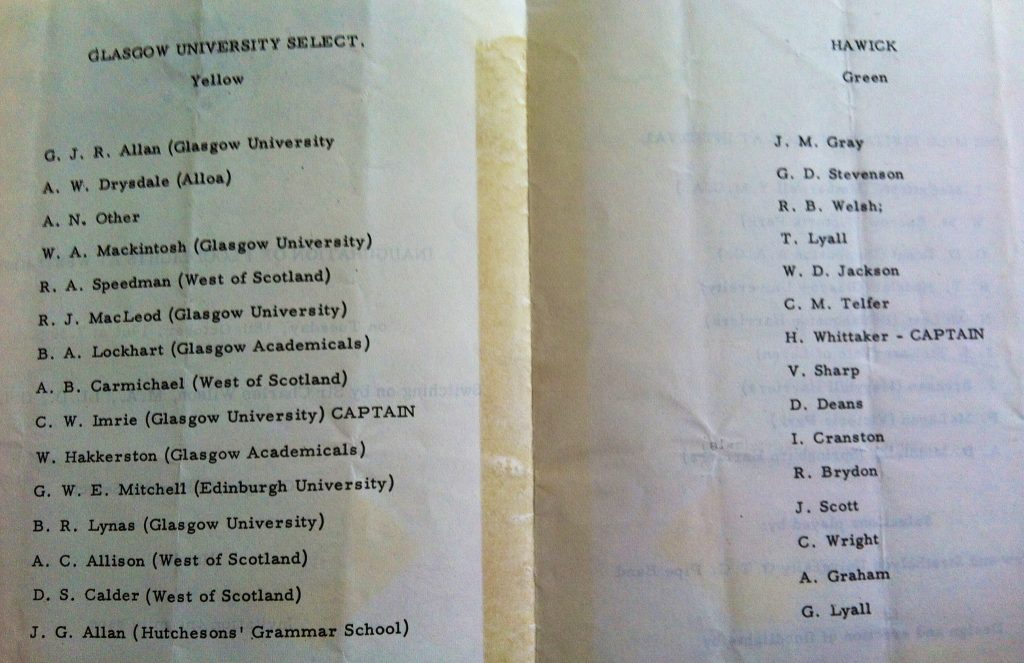
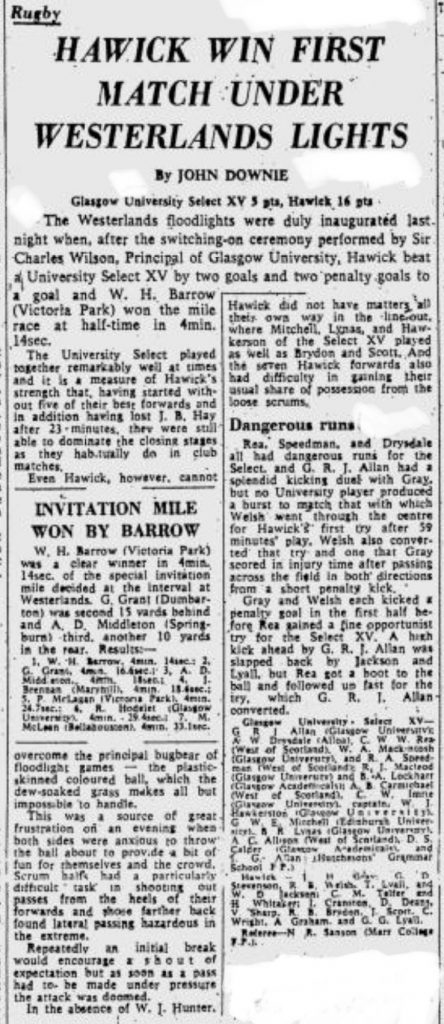
![BUSF%2072%201500%20F[1]](http://www.scottishdistancerunninghistory.scot/wp-content/uploads/2015/10/BUSF-72-1500-F1-1024x689.jpg)
![Pavilion%20Cake%20001[1]](http://www.scottishdistancerunninghistory.scot/wp-content/uploads/2015/10/Pavilion-Cake-0011-1024x766.jpg)
![Des%20plus%20cake%20001[1]](http://www.scottishdistancerunninghistory.scot/wp-content/uploads/2015/10/Des-plus-cake-0011-1024x712.jpg)
